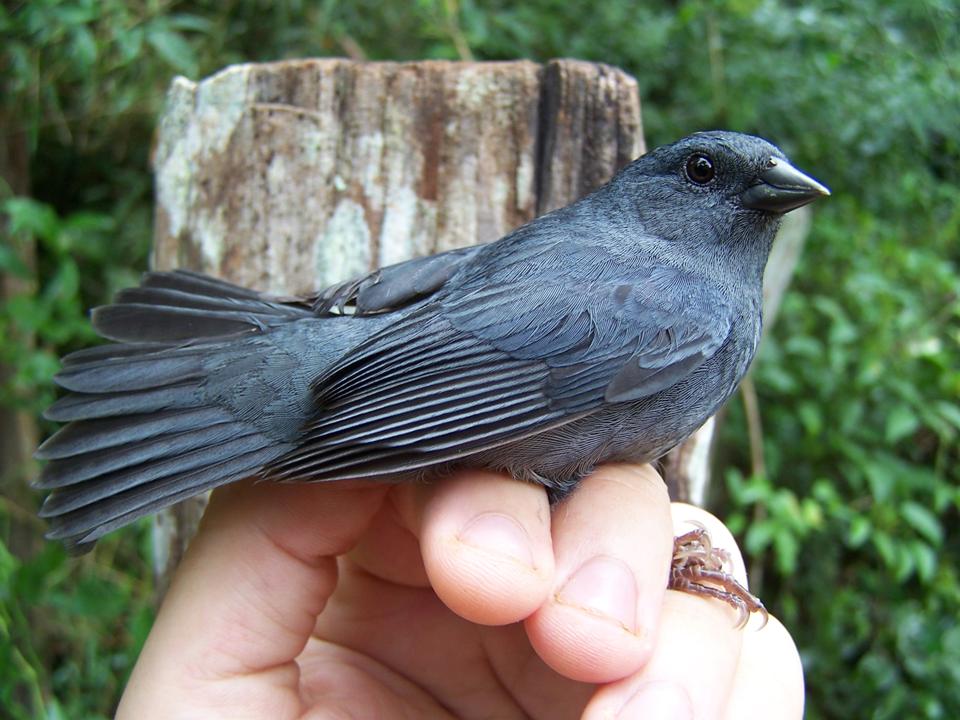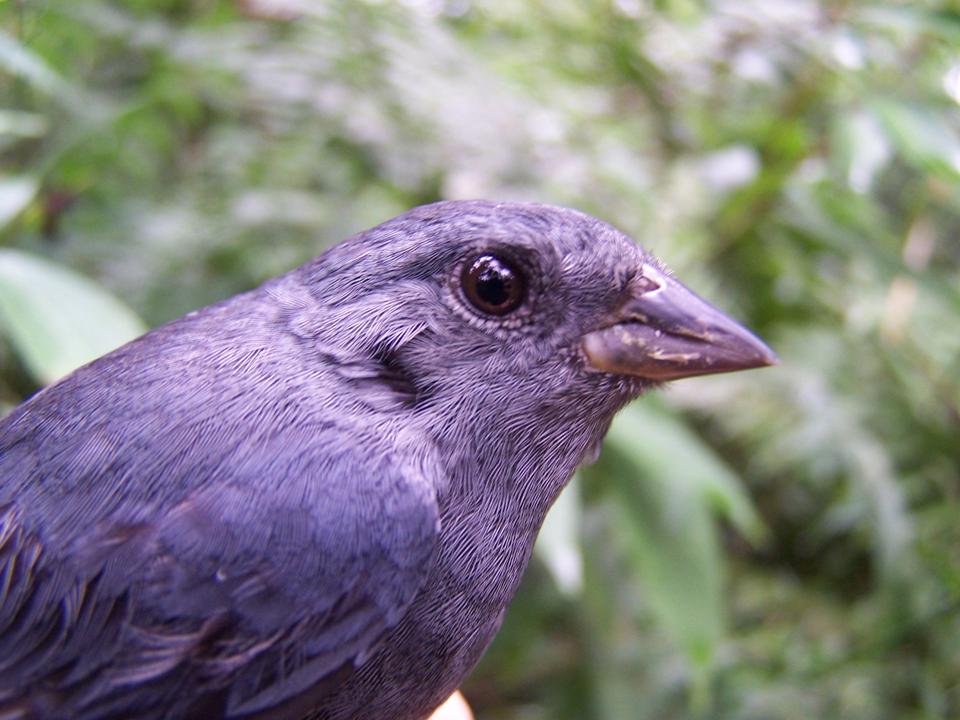
Introduction
Uniform Finch Haplospiza unicolor is an Atlantic Forest endemic species associated with Chusquea and bamboo tangles at humid forest edge (Smith & Clay in prep). It ranges from southern Brazil (Espirito Santo and Minas Gerais to Rio Grande do Sul - Sick 1993), west to eastern Paraguay and extreme northeastern Argentina. Clay & del Castillo (2004) considered it scarce in Alto Paraná region (defined as one record every two or three days, or three or more records in total) and rare in Central Paraguay (less than three records in total).
Though there are very few documented records of the species in Paraguay (Clay & del Castillo 2004, Hayes 1995), in the rest of its range it has been described as “locally and perhaps temporarily…numerous” (Ridgely & Tudor 1989). Here we present details of modern records of the species in Paraguay, including an apparent irruptive event at PROCOSARA, PN San Rafael in March 2007 during which the species was recorded daily in numbers, despite having been recorded only twice previously in the park (F.Hayes in litt.; Madroño et al 1997). A brief review of the previous records of the species in Paraguay is also provided.

PROBABLE IRRUPTIVE EVENT OF UNIFORM FINCH Haplospiza unicolor
AND A SUMMARY OF PREVIOUS PARAGUAYAN RECORDS
Paul Smith

FIG 1: Male Uniform Finch Haplospiza unicolor (Photo Paul Smith)

FIG 2: Presumed immature male Uniform Finch Haplospiza unicolor (Photo Paul Smith)
New Records of Haplospiza unicolor in Paraguay
A continual buzzy zeeee-zooeee brrrrrr was first tape-recorded in dense bamboo at the beginning of the Sendero Urutaú on 17 March 2007. The call was reminiscent of the jumping display call of Blue-black Grassquit Volatinia jacarina with an additional rasping trill added to the end. The bird was tentatively identified as a Uniform Finch after reference to commercial recordings of the species (Gonzaga & Castiglioni 2000). The scratchy, insect-like quality of the call was similar to that of the recordings, but the phrasing was different. Though Ridgely & Tudor (1989) make reference to the variability of the call of the species, the birds calling at San Rafael were consistent in their phrasing, though the trilled ending was occasionally omitted. Birds called daily during the course of fieldwork (17 March - 3 April) with at least five individuals singing almost continuously throughout the day at the same location, and a single individual also heard some 600m away near the river crossing on the same trail.
We were able to confirm the source of the call as Haplospiza unicolor on 27 March 2007 when a male was observed singing from an exposed perch beneath overhanging vegetation at a height of c3m. Three males were mist-netted on 31 March 2007 (Fig 1), including one bird that showed signs of immaturity - pointed tail feathers, duller colouration and a pale yellowish base to the lower mandible (Fig 2). Though males were observed with relative frequency on subsequent days, no females were seen.
The species was not recorded during fieldwork at the same location in March 2006 (Smith et al 2006) and its sudden abundance is suggestive of an irruptive event. Sick (1993) states that in Brazil Haplospiza occurs “in great numbers when bamboo rice is available and then disappears”, including it amongst a group of nomadic bamboo-following Emberizids that include globally threatened species such as Buffy-fronted Seedeater Sporophila falcirostris and Blackish-blue Seedeater Amauropsiza moesta. At approximately the same time that the birds were recorded at PROCOSARA a male was also netted some 18km north within San Rafael National Park at Estancia Kanguery by Leticia López (L.López in litt.).
Previous Records of the Species in Paraguay
Of the six Paraguayan specimens in the UMMZ five were collected at San Rafael during July and August 1978 by RF Storer (specimen numbers 201032-201035 inclusive and 201150). The large number of specimens collected during 1978 may also have been the result of an irruptive event, or perhaps the species was previously more widespread, as deforestation since the early 1980s has been extensive. A sixth specimen was collected at PN Ybycui, Departamento Paraguari on 18 June 1979 by Dr Philip Myers (specimen number 202354) and remains the only record of the species at that locality. The only other modern record from PN San Rafael is of a male specimen (number 88468) with enlarged gonads (8x7.5mm) collected at Estancia Parabel on 11 November 1996 and housed at the Kansas University Natural History Museum (M. Robbins in litt.)
Despite extensive surveys of the Paraguayan Atlantic forest during Project CANOPY 92 and YACUTINGA 95 the species was recorded at only two locations. At Reserva Natural Privada del Ypetí, Departamento Caazapá (5-21 July 1992) the number of individuals encountered was described as “notable considering the species scarcity elsewhere” though its overall status was described as “uncommon” (defined as 2-10 records per 100 hours of fieldwork), whilst at Reserva Natural Privada Itabó (fieldwork 4-20 August 1992, 6-16 December 1994 and 14-23 October 1995) it was described as “rare” - defined as less than 2 records per 100 hours of fieldwork (Lowen et al 1996). Subsequent to this the only modern Paraguayan record is of a female collected at Hotel Tirol, Capitán Miranda, Departamento Itapúa during June 2004 by Mercedes Foster and Carla Cicero, though the author was also present. The species had previously been collected at the site during the early 1980s. Three records from the Itaipú Reserves of Limoy and Itabó and a record from Hernandarias (approximately 25º20'S, 54º40'W), all in Departamento Alto Paraná lack even basic data, including dates. The author is unaware of any other confirmed occurrences of the species in Paraguay.
Conclusion
Uniform Finch is under no global conservation threat and due to the scarcity of records is listed as Data Deficient for Paraguay. Destruction and fragmentation of habitat would appear to be the major threats to the species in Paraguay, but the irruptive nature of the species makes it difficult to assess its true status - the species can appear periodically common before disappearing completely from any given location. Furthermore its secretive nature and inconspicuous call mean that it is easily overlooked by observers not familiar with the species.
REFERENCES:
1.Clay RP, del Castillo H 2004 - Annotated Checklist of the Birds of Paraguay - Guyra Paraguay, Asunción.
2.Gonzaga LP, Castiglioni G 2000 - Aves das Montanhas do Sudeste do Brasil - Arquito Sonoro Prof. Elias Coelho.
3.Guyra Paraguay Biodiversity Database
4.Lowen JC, Bartrina L, Clay RP, Tobias JA 1996 - Biological Surveys and Conservation Priorities in Eastern Paraguay - CSB Conservation Publications
5.Madroño A, Clay RP, Robbins MB, Rice NH, Faucett RC, Lowen JC 1997 - An Avifaunal Survey of the Vanishing Interior Atlantic Forest of San Rafael National Park, Departments Itapúa/Caazapá, Paraguay - Cotinga 7: p45-53.
6.Ridgeley RS, Tudor G 1989 - The Birds of South America Vol 1: The Oscine Passerines - Oxford University Press.
7.Smith P, del Castillo H, Bankovics A, Hansen L, Wainwright B 2006 - An Avifaunal Inventory of San Rafael “National Park”, Departamento Itapúa, Southern Paraguay - FAUNA Paraguay Technical Publication Number 3.
8.Smith P, Clay RP in prep. - A Field Guide to the Birds of Paraguay - Christopher Helm
Thanks to:
Hugo del Castillo for providing information from the Guyra Paraguay Biodiversity Database about previous records of this species. Floyd Hayes for providing specimen details for the UMMZ, Leticia López for her photograph to confirm the identification of the Estancia Kanguery specimen and Janet Schumacher for accompanying me in the field. Mark Robbins and Krystof Zykowski both provided information about previous specimens from San Rafael.
Designed by Paul Smith 2006. This website is copyrighted by law.
Material contained herewith may not be used without the prior written permission of FAUNA Paraguay.
Photographs on this web-site were taken by Paul Smith, Hemme Batjes, Regis Nossent,
Alberto Esquivel, Arne Lesterhuis, José Luis Cartes, Rebecca Zarza and Hugo del Castillo and are used with their permission.



